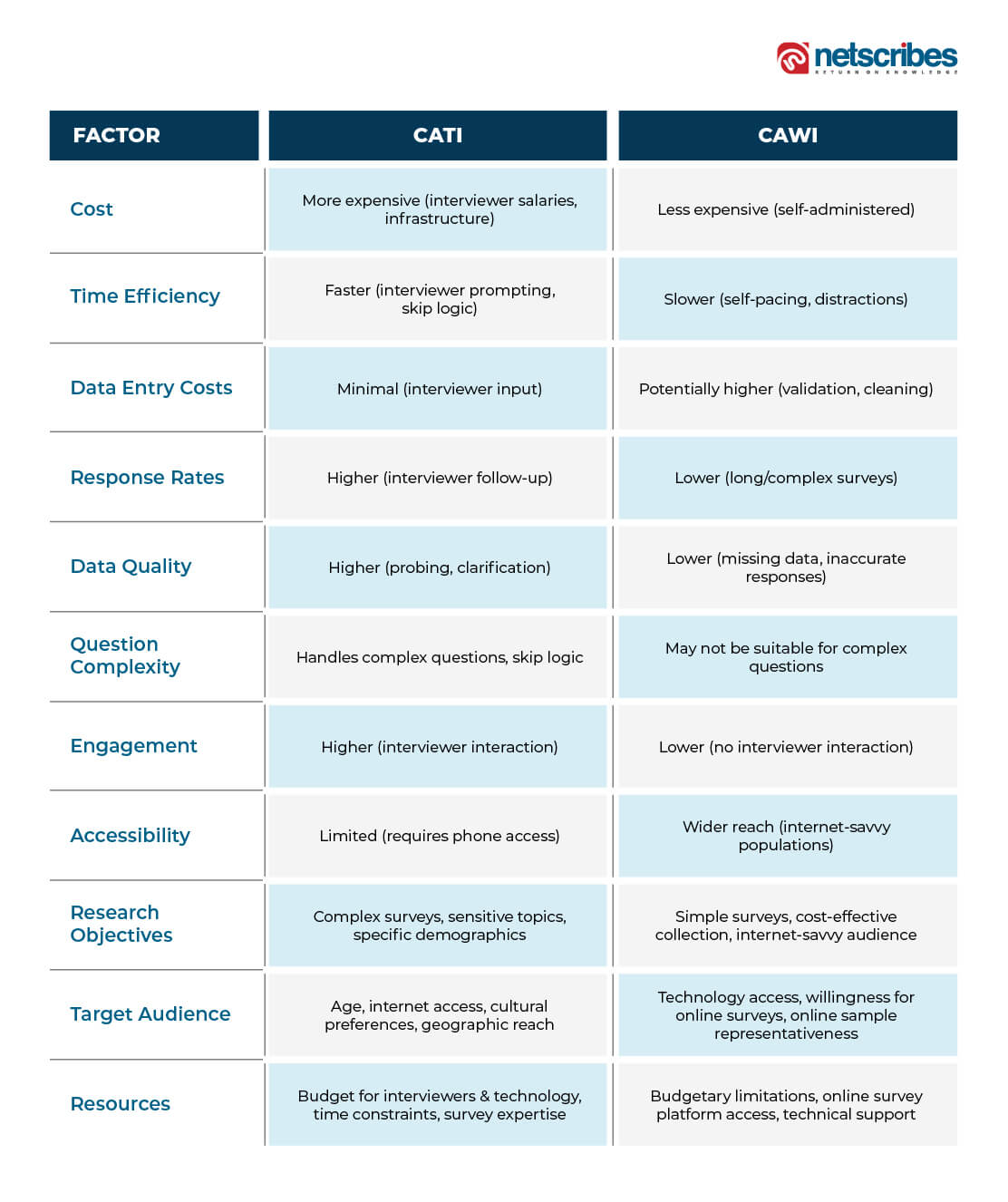Key highlights
- By employing skilled interviewers, CATI gathers qualitative data, while CAWI gathers a broad range of opinions quickly and inexpensively through online surveys.
- CAWI's digital speed suits simple surveys, reaching large, internet-savvy audiences, while CATI's human touch fosters trust and rapport.
- A CATI survey benefits from its flexibility and probing capabilities, while a CAWI survey benefits from its ease of use and rapid data collection.
- Combining CATI and CAWI can be a winning strategy, offering multidimensional insights through different strengths, leading to better informed decisions.
Nothing can replace first-hand information, especially when looking for answers that demand nuance and context. With time, researchers have honed primary research methodologies, which have evolved into various types. In this blog, we will talk about two robust research tools. These include Computer-Aided Telephone Interviews (CATI) and Computer-Aided Web Interviews (CAWI), better known as online surveys.
While both methods utilize technology, their approaches differ significantly. Computer aided telephone interviews, through direct human interaction, fosters trust and allows deeper exploration beyond surface-level responses. Its strength lies in its ability to navigate complex questions and uncover hidden layers of meaning that might be missed in digital formats. CAWI, on the other hand, effortlessly reaches diverse audiences across digital platforms. Its streamlined format and anonymity encourage participation, producing vast amounts of data for analysis.
Due to the variety of tools available today, the question inevitably arises, which tool is best suited to your research needs? Let’s first understand both methodologies
Understanding CATI (Computer-Aided Telephone Interview)
CATI or computer-aided telephonic interview is a method of conducting interviews via phone calls. However, computer assistance adds an additional dimension to the process. Here, an interviewer guides the conversation and records responses with a software program. This software usually displays questions on a screen. It allows skips and branches based on answer choices, where follow-up questions adapt based on previous responses, and helps manage quotas and call timing.
From its early days as bulky landline technology, computer aided telephone interviews have transformed dramatically. Today, sophisticated cloud-based platforms and mobile apps have replaced clunky hardware, allowing for greater interviewer mobility and wider reach. This evolution has also ushered in multimedia integration. This feature allows researchers to present images, audio, or even video clips during interviews, further enriching the data collection process.
Exploring CAWI (Computer-Aided Web Interview)
Computer-Aided Web Interviewing (CAWI), also known as online interviewing, is a research data collection method where respondents interact with pre-programmed questionnaires hosted on a web platform. Using their own internet-connected devices, respondents navigate through the survey at their own pace. They can then select answers and provide information in a self-guided manner.
The rise of internet penetration and mobile technology has made CAWI a potent research tool. Its accessibility, anonymity, and convenience for respondents attract high participation rates, especially among younger demographics. Additionally, CAWI offers cost-effectiveness for large-scale surveys and real-time data analysis, enabling researchers to quickly track trends and adjust their questions if needed.
On the downside, research suggests that the average person can become distracted in just 8 seconds. Meaning, getting people to participate and even if they do, ensuring the data is valid can be challenging with this methodology.
Comparative analysis: CATI vs CAWI
When embarking on the research journey, navigating the choice between Computer-Aided Telephone Interviewing (CATI) and Computer-Aided Web Interviewing (CAWI) can be a strategic decision. Both methods offer invaluable insights, but excel in distinct terrains.
CATI delves into the complexities of human behavior, exploring sensitive topics, or unraveling the “whys” behind customer choices. Skilled interviewers can navigate these intricate landscapes, unearthing valuable qualitative data often inaccessible through text boxes and screens. CATI’s strength lies in fostering human connection, allowing respondents to articulate their experiences in a natural and detailed manner. This makes it ideal for exploring product concepts and understanding customer journeys. Benefits of CATI include:
On the other hand, CAWI excels in speed and reach. Online surveys, crafted with precision, can be disseminated to thousands in an instant, delivering rapid results at a fraction of the cost. This efficiency makes CAWI invaluable for large-scale quantitative research, gathering representative samples and capturing a broad spectrum of opinions. Yet, it’s crucial to acknowledge its limitations. Complex questions can be cumbersome in online formats, and nuances of emotion or sentiment might get lost in the digital translation. So, what is the right approach?

Real-world examples of CATI and CAWI in action
A global health insurance giant, with customers across a dozen countries, sought to better understand its brand health. In addition to selling policies, they navigated the unique needs of students, professionals, and retirees seeking security abroad. In order to refine their brand message and stand out among their competitors, they needed razor-sharp insights.
To meet their objectives, Netscribes devised a hybrid research approach, combining the web-based reach of CAWI with the personalized touch of computer aided telephone interviews. Each segment of our customer base was represented by over 2000 participants, providing a snapshot of their underlying preferences, perceptions, and purchasing motivations.
The study revealed a wealth of insights. By mapping preferred insurers for each group, discovering the most popular plan types, and deciphering the key decision-making factors, they were able to identify the key factors that drove customers to select one insurer over another.
Therefore, by combining CAWI and CATI, the insurance giant gained multi-dimensional insights that helped them develop trust among its clientele. They fine-tuned their marketing strategy, laser-focusing on messaging that resonated with each segment. Furthermore, they tailored their product offerings with customer-centric improvements, ensuring relevance and value in every market.
Key takeaway: CATI or CAWI?
Even so, it still begs the question, which route to choose?
As we saw in the case above, for this particular insurer, a combination of both CAWI and CATI methodologies ultimately helped meet their research objectives. However, that may not always be the case. In the end, the optimal approach lies in understanding the strengths and limitations of each method. This can be furthered by selecting the one that best aligns with your research objectives.
Netscribes’ primary research services leverage both Computer-Aided Web Interviews (CAWI) and Computer-Aided Telephone Interview (CAWI) approaches for qualitative as well as quantitative research. Having worked with global brands and some of the world’s leading consulting firms for the past two decades, Netscribes’ comprehensive insights have been instrumental in assisting with new market entry, product development, brand communications, and customer experience. Want to learn more about the best primary research methodology for you? Contact us now.






